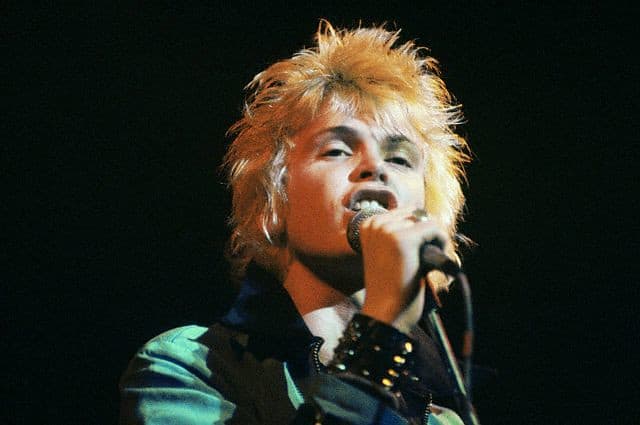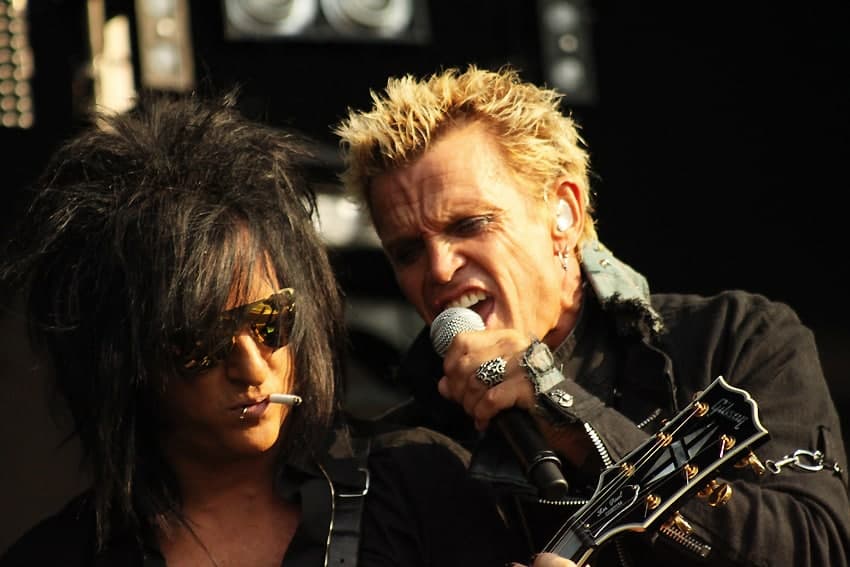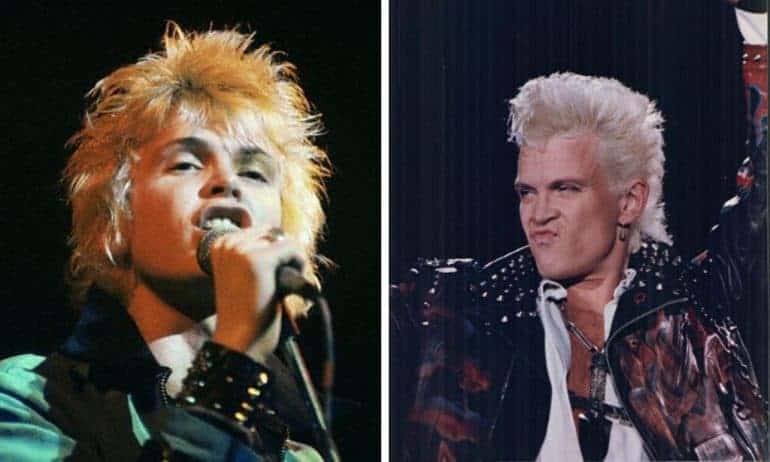Our top 10 best Billy Idol songs list explores the music of a punk rock pioneer in the 1970s and global superstar in the 1980s.
Top 10 Best Billy Idol Songs
10. To Be a Lover
The track was featured from his 1986 album Whiplash Smile. It was the album’s lead single and secured a second top 10 hit for Idol on the Billboard Hot 100. The song has been reworked, sampled, and covered by numerous other musicians.
9. Catch My Fall
This single was featured from the album Rebel Yell. The song reached the 50th spot on the Billboard Hot 100 and 63rd spot in the UK charts. One of the best Billy Idol songs that show his versatility as an artist and how his style wasn’t just one genre.
8. Cradle of Love
This particular track was released as the first single from the album Charmed Life in 1990. The track ended up being one of the highest-selling Billy Idol songs in the United States. The song secured the 2nd spot on the Billboard Hot 100 but was barred from reaching the top spot by Mariah Carey’s Vision of Love.
7. Hot in the City
This song was released as the first single from his debut self-titled album in 1982. The song peaked at the 23rd spot on the Billboard Hot 100 and 58th spot on the UK charts. The song follows a slick bassline and beautiful instrumentals, which provide a chill laid-back feeling to the track.
6. Flesh for Fantasy
This track was released as the third single from his album titled Rebel Yell in 1983. The song reached the 29th spot on the Billboard Hot 100 and the 54th spot on the UK charts. The track is a mixture of new wave and rock ‘n’ roll, which shows the creative direction Idol was headed towards in his solo career.
5. Eyes Without a Face
Quite different from most Billy Idol songs, the track has a ballad style of music and is more soft-spoken. The song reached the 4th spot on the Billboard Hot 100 and became his first top 10 hit, establishing Idol as a well-recognized musician.
4. White Wedding
One of the most popular Billy Idol songs, the track was released as the second single from his debut album in 1982. The song reached the 36th spot on the Billboard Hot 100 and 6th spot on the UK Singles Chart. The song features a heavy bass line with subtle hints of electronica.
3. Mony Mony
The cover of Tommy James’s “Mony Mony” by Idol from his album Vital Idol in 1987 made quite the impact on his career. Idol had covered the song on his 1981 EP titled Don’t Stop, but it gained prominence on the charts when the live version was released from Vital Idol.
2. Dancing with Myself
One of our favorite Billy Idol songs, the track was featured from his self-titled album. The song was originally featured in the Generation X album titled Kiss Me Deadly. The song peaked at the 27th spot on the US Hot Dance Play Charts when it was re-released as a single from Billy as a solo artist. Billy was praised for being able to blend rock music with dance music easily. It is one of his signature songs.
1. Rebel Yell
We reserved the best for the last, and it is no surprise to all of us with a track like “Rebel Yell.” The single was released from the album Rebel Yell in 1983. It is by far one of the best Billy Idol songs and the track that people really know him for.
The song skyrocketed his career and established him as an icon in music history. The lead single reached the 46th spot on the Billboard Hot 100 and peaked at the 6th spot on the UK charts. The song earned the 79th spot on the best hard rock song of all time under public voting held by VH1.
Further Listening: 10 Best Joan Jett Songs
Billy Idol – History
Billy Idol was born in Middlesex, England, on November 30th, 1955. His full name was William Michael Albert Broad. Billy Idol is an English artist as well as a songwriter, but Idol is also an actor and enjoys being in front of the camera.
Billy is associated with record labels such as Chrysalis, EMI, Sanctuary, and BFI. Idol has been present in the music scene since 1976 and has also collaborated with artists such as Chelsea, Generation X, and Steve Stevens. His musical style of genre includes punk rock, hard rock, glam rock, new wave, and post-punk.
Childhood & Career Formation
Idol’s mother was of Irish ancestry and his family were of Anglican faith and went to their community church regularly. In 1958, Idol and his family moved to New York to a place called “Patchogue” and they also were residents of New York in a center called “Rockville.”
Idol’s sister was born in New York, but the family, later on, moved back to Dorking, Surrey, where they settled. However, they later moved to Bromley, London permanently, and Idol was admitted to Ravensbourne School, which was a school for boys and Worthing School. Which was also for boys, situated in Worthing, West Sussex. Idol went on to pursue a degree in English at Sussex University.
After a year, Billy left his degree to pursue music. He, later on, joined the Contingent of Bromley. This contingent consisted of Sex Pistols fans. The contingent consisted of crew members who traveled around town whenever the group would put on live shows.

The idea behind his name came from Billy’s school teacher, who was a chemistry teacher. The teacher described Billy as an idle child in his chemistry class, in which Billy hated the subject. Hence he was called ‘Billy Idle.’ However, he changed it to ‘Billy Idol’ because an artist called ‘Eric Idle’ also had the same last name during that time.
Idol had joined the group, Chelsea, as a guitarist in 1976, which was a new band from West London during the 1960s. Gene October, who was the lead vocalist of the band, had advised Idol to get rid of his glasses. He told Billy to start wearing contact lenses.
Billy was also advised to change his hair color and to go blonde, with a crew haircut style to better fit the band’s retro 1950s rock ‘n’ roll image. The crew cut was the trend during the 1970s. Tony James was also a member of Chelsea. But after moving away creatively, Billy, along with Tony, left the band after performing and started a group called Generation X. Idol switched places and went from being a guitarist to becoming the lead vocalist.
Generation X’s major highlight was the fact that they were the first-ever punk rock band to make a television appearance on the BBC on Top of the Pops.
Generation X earned their first record deal with the Chrysalis label, which led to them releasing three studio albums. The band, later on, decided to split.
Solo Career – Success
In 1981, Billy decided to leave for New York in pursuit of becoming a solo musician. Billy associated himself with Bill Aucoin, the former manager of the band Kiss to start his career. Idol had a punk rock image that blended perfectly with the glam rocker image of his guitarist Steve Stevens. The duo worked with drummer Gregg Gerson and bassist Phil Feit.
Billy’s career as a solo musician took off with the release of his EP in 1981 called Don’t Stop. It featured the old song of Generation X “Dancing with Myself,” which was meant to be a track on their final album. The EP also featured a cover of a Tommy James & the Shondells song, “Mony Mony.”
In 1982, he released his debut solo album, Billy Idol. His second LP, Rebel Yell, released in 1983, sky-rocketed his career as a solo artist and led to global success and recognition. The LP featured popular singles such as “Rebel Yell” and “Flesh for Fantasy.”
One of the popular tracks from the album was “Eyes Without a Face.” The track peaked on the 4th spot on the US charts. In the UK, “Rebel Yell” reached the 6th spot. The album, including the singles, gained popularity in countries like New Zealand and Germany along with other European countries.

In 1986, Billy released his next album Whiplash Smile. The album sold well and featured singles such as “Sweet Sixteen” and “To Be a Lover.” The album also included one of the most popular Billy Idol songs, “Don’t Need a Gun.”
While working on the album, Stevens collaborated alongside Harold Faltermeyer for the soundtrack of the movie Top Gun. The success of the soundtrack led to various other opportunities for Stevens, which led to the downfall of his relationship with Idol. However, they collaborated during the mid-90s but didn’t tour together until 1999.
In 1987, a new album which contained remixes titled Vital Idol was released, which featured a live cover version of “Mony Mony.” The cover track peaked at the top spot of the Billboard Hot 100 and also reached the 7th spot on the UK charts.
Fatherhood – Accident – Filmography
In the late 1980s, Idol moved to Los Angeles with his significant other from New York, Perri Lister. The couple gave birth to Willem Wolfe Broad on June 15th, 1988. However, Idol, being surrounded by fame and wealth while being exposed to the finer things in life, didn’t stay faithful to Perri and ditched her for Linda Mathis.
Idol was 13 years older than Mathis when they were dating. Mathis gave birth to Idol’s second child, who was a beautiful daughter called Bonnie Blue Broad on August 21st, 1989.
On February 6th, 1990, Idol was in a tragic motorcycle accident where he nearly lost his leg in Hollywood, California. The incident followed a car hitting him when he accidentally drove through a stop sign on his way back home from the studio one night.
Around the same time as the accident, renowned filmmaker Oliver Stone chose Idol to be in his upcoming movie titled The Doors. However, Idol wasn’t healed properly from the accident and was unable to engage in huge stunts and roles, and so he ended up securing a small scene in the movie.
Another filmmaker, James Cameron, also wanted Billy to be in his movie Terminator 2: Judgement Day for the part of the villain T-1000. But like the earlier incident, Idol failed to secure the role because of his accident, and the role was recast
Decline
In 1990, Idol’s released his next album Charmed Life. The album featured the track Cradle of Love, which was included in the movie The Adventures of Ford Fairlane by Andrew Dice Clay.
The song had a music video that was heavily rotated on MTV where Idol was recorded by the camera from the waist up only because he still couldn’t walk. The single achieved a Grammy nomination. The award was listed in the category of Best Male Rock Vocal Performance.
In 1993, Billy released his next studio album titled Cyberpunk, which, to him, was an experimental project. The album took a span of 10 months to be produced and released. He collaborated with Mark Younger-Smith, who was the guitarist on the recordings.
The album also contained special editions versions that came with a floppy disk with an attached screensaver. The album gained popularity and success in the UK and other European countries but failed to take off in the US.
Just like most big musicians, Idol began to abuse drugs and ended up collapsing right outside a nightclub in LA in 1994 as a result of an overdose of GHB. It was a legalized drug used during that time by most weightlifters to excel in their profession. Idol recovered from the overdose and decided to redirect his life towards the betterment of his family.
After the overdose, Idol and Stevens worked together on a track titled “Speed”, which was meant for the film of the same name’s soundtrack, starring Sandra Bullock and Keanu Reeves. Idol avoided making and putting out any albums during this time as he was facing issues with his label over creative pursuits.
Idol also appeared on various television shows, cameos, as well as guest appearances on projects of other artists in the industry. VH1 also aired the Behind the Music series on Billy Idol on April 16th, 2001. Both Billy and Stevens also took part in VH1’s storyteller. The pair collaborated again to continue playing an array of acoustic performances and storytelling shows before recording the VH1 special.
In 2005, Billy made a comeback onto the music scene after a hiatus of 12 years. Idol once again collaborated with Stevens and Keith Forsey to record and put out an album. Sanctuary Records had approached Idol to create new music in his older style, the result was Devil’s Playground. The album reached the 46th spot on the Billboard Hot 200.
Throughout his many adventures, Billy Idol has left a legacy of great music along the way. Idol was always creative in his work, which led to him engaging in different genres of music.
He never failed to deliver great music to his fans and also the music industry in general. He is an icon in music history, and his work still continues to inspire upcoming artists today.
We hope you’ve enjoyed our top 10 best Billy Idol songs list and a brief history of this legendary artist.
More Music Lists…
- The Alice Cooper Fact Sheet – 5 Things You Need To Know - January 12, 2023
- Everybody Knows The Words, But What Is Hotel California About? - April 29, 2022
- What Is The Meaning Of Stairway To Heaven: Led Zeppelin’s Amazing 1971 Musical Epic? - April 24, 2022


